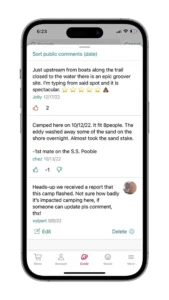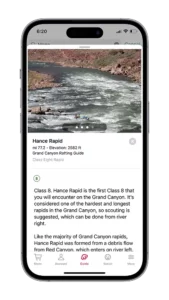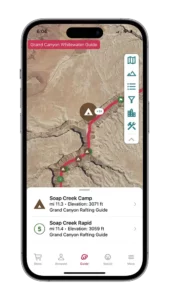About Lava Falls Rapid
Lava Falls rapid is the most anticipated rapid on the river. The Uinkaret Volcanic Field deposited masses of Lava into the Grand Canyon between 75,000 and 100,000 years ago. These lava deposits dammed the river, starting in the vicinity of Lava Falls Rapid. Eventually, the Colorado broke through the natural dams. You can see enormous deposits of columnar basalt on river right as you finish the rapid.
How to run Lava Falls Rapid
Lava Falls has many interesting features, most of which are broken down in the labeled image above.
- The Ledge Hole. This is the largest hole on the river. Avoid it all costs.
- Hump Wave AKA the Lateral Wave. Hitting this is known as The Dory Line, it sets you up well for everything downstream.
- Pour Over. This is large and should be avoided.
- The V-Wave. This wave is two laterals that come together.
- Big Kahuna. This is the tallest wave in the wave train below the V-Wave.
- Corner Pocket. You are having a really bad day if you end up here. Avoid.
- Saddle Rock AKA Black Rock. This rock has more names than the two listed here, but either way, you don’t want to get too close to it.
- Lava Springs. If you’re thinking about this then you’ve probably made it through Lava Falls upright.
The most consequential feature of Lava Falls is the notorious Ledge Hole in the center of the river. Whatever you do, avoid the Ledge Hole. This means you need to go left or right of it. Right is the standard line for flows below 15,000 CFS. If you go right, then the typical line is to aim for the Hump Wave (#2) with some right to left motion. If your right to left momentum is good it will carry you through the wave and on track to be on the left side of the V-Wave (#4). Once you square up to the V-Wave lateral, keep your eyes peeled for Big Kahuna (#5) and hit it straight. By this point, you’re good to go.
Follow the bubble line
What makes Lava Falls challenging is it’s very hard to tell where you are located above the rapid, because it’s steep. Like many Grand Canyon rapids, your success is largely dependent on how you enter, so to help with this, while scouting, pick out visual markers to guide you through the line. For most, this means studying the bubble line on the lead-in and visualizing where you want your raft to be in relation to it. At some flows, the bubble line is spot on for a clean run. Other flows, you may want to be a few feet to the right or left of it.







